![]()
![]()
![]()
Use LEFT and RIGHT arrow keys to navigate between flashcards;
Use UP and DOWN arrow keys to flip the card;
H to show hint;
A reads text to speech;
23 Cards in this Set
- Front
- Back
|
Gait cycle Terminology |
Gait cycle: one stride (two steps)• |
|
|
Periods Terminology 2 |
Periods: stance and swing |
|
|
Phases Terminology (8) |
Phases (8) 1.Initial contact 2.Loading response 3.Mid stance 4.Terminal stance 5.Pre-swing 6.Initial swing 7.Mid swing 8.Terminal swing |
|
|
Functional tasks Terminology (3) |
Functional tasks (3)
|
|
|
Rockers Terminology (4) |
Rockers (4):
|
|
|
Phases and functional tasks of the gait cycle |

|
|
|
Phases of the gait cycle |
Phases of the gait cycle
Stance (~60%) 1.Initial contact 2.Loading response 3.Mid stance 4.Terminal stance 5.Pre-swing
Swing (~40%) 6.Initial swing 7.Mid swing 8.Terminal swing |
|
|
1. Initial contact |
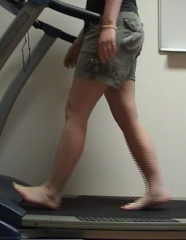
1. Initial contact DLS •The moment the foot (heel) first contacts the ground •Represents first ~2% of the total gait cycle •Initial period of DLS |
|
|
2. Loading response |

2. Loading response DLS •Period between initial contact to ‘toe off’ of the opposite foot •Represents ~2-10% of the total gait cycle •Period of DLS, ending when opposite foot leaves ground |
|
|
3. Mid stance |

3. Mid stance SLS •Period from when opposite foot leaves the ground till heel rise of the other foot •Represents ~10-30% of the total gait cycle •COM moves over stance leg •Period of SLS Ends when heel starts to leave ground
|
|
|
4. Terminal stance |
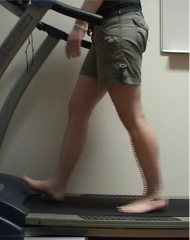
4. Terminal stance SLS •Period from heel rise of foot to initial contact of opposite foot •Represents ~30-50% of the total gait cycle •Period of SLS, ending with initial contact of the opposite foot |
|
|
5. Pre-swing |
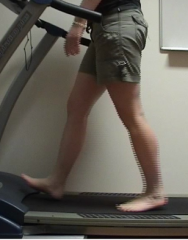
5. Pre-swing DLS •Period from initial contact of opposite foot to toe-off of foot •Represents ~50-60% of the total gait cycle •Second period of DLS, ending when toes of supporting limb leave the ground |
|
|
6. Initial swing |
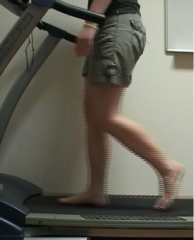
6. Initial swing SLS •Period from toe-off to point where feet sit opposite from each other •Represents ~60-73% of the total gait cycle •Second period of SLS Ends at point when feet cross over each other. |
|
|
7. Mid swing |

7. Mid swing SLS •Period from feet being opposite each other to tibia of swinging leg being vertical (perpendicular to ground) •Represents ~73-87% of the total gait cycle •Period of SLS
Ends when tiber is vertical
|
|
|
8. Terminal swing |
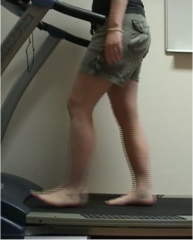
8. Terminal swing •Period from vertical tibia to moment just prior to initial contact •Represents ~87-100% of the total gait cycle •Period of SLS, ending with initial contact(new gait cycle) Ends just before heel hits ground |
|
|
Functional events of the gait cycle 1.Weight acceptance
|
Functional events of the gait cycle 1.Weight acceptance
(initial contact → loading response)
•Most demanding functional task (first 10%) 1.Shock attenuation •Deceleration 2.Transfer weight to the stance leg 3.Maintain forward progression
•Shock attenuation is achieved through the eccentric contraction of:
•Anterior leg muscles → controlled ankle plantarflexion
•Ankle invertors (tibialis anterior, tibialis posterior) → controlled ankle eversion
•Quadriceps → controlled knee flexion
•Gluteal group → controlled hip flexion
•Transfer of weight to the stance limb is achieved by:
•Hip adduction of the stance limb, controlled by eccentric contraction of the hip abductors
•Continuation of forward progression is achieved by:
•Heel rocker (posterior surface of the calcaneus) |
|
|
Functional events of the gait cycle 2.Single limb support |
2.Single limb support (mid stance → terminal stance) 1.Forward progression; body passes from behind the stationary foot to being in front of the stationary foot 2.Maintain stability •Represents approximately 40% of the gait cycle •Achieved through the ankle, forefoot and toe rockers |
|
|
Functional events of the gait cycle 3.Swing limb advancement |
3.Swing limb advancement (pre swing → terminal swing) Goal is to ‘unload’ and move the swing leg from behind the body, to in being in front of the body 1.Preparation for swing/acceleration of the limb 2.Ground clearance 3.Swing limb advances from behind the body to in front of the body |
|
|
Rockers |
Rockers •Can be used to describe mechanisms to enhance forward progression during the stance phase of the gait cycle 1.Heel 2.Ankle 3.Forefoot 4.Toe |
|
|
Heel rocker |
Heel rocker •During walking, the heel is typically the first part of the foot to contact the ground •The rounded plantar/posterior surface of the calcaneus (tuberosity) acts as the fulcrum •Allows the foot to be lowered to the ground, maintains forward progression inishal contact and load response |
|
|
Ankle rocker |
Ankle rocker •Once the foot has been lowered to the ground the body must move from behind the foot to being in front of the foot •The ankle becomes the fulcrum as the tibia passes over the ankle/foot, maintaining forward progression •Determined by ankle joint dorsiflexion range of motion
Use ankle to DF Mid stance |
|
|
Forefoot rocker |
Forefoot rocker •As the heel lifts of the ground, bodyweight is transferred to the forefoot •The rounded, plantar surfaces of the metatarsal heads act as the fulcrum, maintaining forward progression •Determined by the dorsiflexion range of motion at the metatarsophalangeal joints
Test first MTPJ jacks test S & f AHL will have problems |
|
|
Toe rocker |
Toe rocker •Plantar surface of the hallux and most anterior aspect of medial forefoot •Last pivot/point of contact as limb prepares for swing •Contralateral limb will now be in contact with the ground (heel rocker)
Last point to push off ground Pre swing
Also be using heel rockers of other foot when heel rockers |

